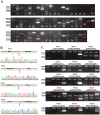Profile of chimeric RNAs and TMPRSS2-ERG e2e4 isoform in neuroendocrine prostate cancer
- PMID: 36088396
- PMCID: PMC9463804
- DOI: 10.1186/s13578-022-00893-5
Profile of chimeric RNAs and TMPRSS2-ERG e2e4 isoform in neuroendocrine prostate cancer
Abstract
Purpose: Specific gene fusions and their fusion products (chimeric RNA and protein) have served as ideal diagnostic markers and therapeutic targets for cancer. However, few systematic studies for chimeric RNAs have been conducted in neuroendocrine prostate cancer (NEPC). In this study, we explored the landscape of chimeric RNAs in different types of prostate cancer (PCa) cell lines and aimed to identify chimeric RNAs specifically expressed in NEPC.
Methods: To do so, we employed the RNA-seq data of eight prostate related cell lines from Cancer Cell Line Encyclopedia (CCLE) for chimeric RNA identification. Multiple filtering criteria were used and the candidate chimeric RNAs were characterized at multiple levels and from various angles. We then performed experimental validation on all 80 candidates, and focused on the ones that are specific to NEPC. Lastly, we studied the clinical relevance and effect of one chimera in neuroendocrine process.
Results: Out of 80 candidates, 15 were confirmed to be expressed preferentially in NEPC lines. Among them, 13 of the 15 were found to be specifically expressed in NEPC, and four were further validated in another NEPC cell line. Importantly, in silico analysis showed that tumor malignancy may be correlated to the level of these chimeric RNAs. Clinically, the expression of TMPRSS2-ERG (e2e4) was elevated in tumor tissues and indicated poor clinical prognosis, whereas the parental wild type transcripts had no such association. Furthermore, compared to the most frequently detected TMPRSS2-ERG form (e1e4), e2e4 encodes 31 more amino acids and accelerated neuroendocrine process of prostate cancer.
Conclusions: In summary, these findings painted the landscape of chimeric RNA in NEPC and supported the idea that some chimeric RNAs may represent additional biomarkers and/or treatment targets independent of parental gene transcripts.
Keywords: Chimeric RNA; Neuroendocrine prostate cancer; TMPRSS2-ERG.
© 2022. The Author(s).
Conflict of interest statement
The authors declare that they have no competing interests.
Figures






Similar articles
-
Overexpression of prostate-specific TMPRSS2(exon 0)-ERG fusion transcripts corresponds with favorable prognosis of prostate cancer.Clin Cancer Res. 2009 Oct 15;15(20):6398-403. doi: 10.1158/1078-0432.CCR-09-1176. Epub 2009 Oct 13. Clin Cancer Res. 2009. PMID: 19825963
-
Polycomb-mediated silencing in neuroendocrine prostate cancer.Clin Epigenetics. 2015 Apr 3;7(1):40. doi: 10.1186/s13148-015-0074-4. eCollection 2015. Clin Epigenetics. 2015. PMID: 25859291 Free PMC article.
-
Landscape characterization of chimeric RNAs in colorectal cancer.Cancer Lett. 2020 Oct 1;489:56-65. doi: 10.1016/j.canlet.2020.05.037. Epub 2020 Jun 10. Cancer Lett. 2020. PMID: 32534173
-
Role of MicroRNAs in Neuroendocrine Prostate Cancer.Noncoding RNA. 2022 Mar 30;8(2):25. doi: 10.3390/ncrna8020025. Noncoding RNA. 2022. PMID: 35447888 Free PMC article. Review.
-
PCA3 and TMPRSS2-ERG gene fusions as diagnostic biomarkers for prostate cancer.Chin J Cancer Res. 2016 Feb;28(1):65-71. doi: 10.3978/j.issn.1000-9604.2016.01.05. Chin J Cancer Res. 2016. PMID: 27041928 Free PMC article. Review.
Cited by
-
Darolutamide-mediated phospholipid remodeling induces ferroptosis through the SREBP1-FASN axis in prostate cancer.Int J Biol Sci. 2024 Sep 3;20(12):4635-4653. doi: 10.7150/ijbs.101039. eCollection 2024. Int J Biol Sci. 2024. PMID: 39309439 Free PMC article.
-
Chimeric SFT2D2-TBX19 Promotes Prostate Cancer Progression by Encoding TBX19-202 Protein and Stabilizing Mitochondrial ATP Synthase through ATP5F1A Phosphorylation.Adv Sci (Weinh). 2024 Dec;11(48):e2408426. doi: 10.1002/advs.202408426. Epub 2024 Nov 14. Adv Sci (Weinh). 2024. PMID: 39540264 Free PMC article.
-
A protein-encoding CCDC7 circular RNA inhibits the progression of prostate cancer by up-regulating FLRT3.NPJ Precis Oncol. 2024 Jan 16;8(1):11. doi: 10.1038/s41698-024-00503-2. NPJ Precis Oncol. 2024. PMID: 38225404 Free PMC article.
-
Oncogenic SLC2A11-MIF fusion protein interacts with polypyrimidine tract binding protein 1 to facilitate bladder cancer proliferation and metastasis by regulating mRNA stability.MedComm (2020). 2024 Aug 14;5(9):e685. doi: 10.1002/mco2.685. eCollection 2024 Sep. MedComm (2020). 2024. PMID: 39156764 Free PMC article.
-
PET imaging of new target CDK19 in prostate cancer.Eur J Nucl Med Mol Imaging. 2023 Sep;50(11):3452-3464. doi: 10.1007/s00259-023-06277-2. Epub 2023 Jun 6. Eur J Nucl Med Mol Imaging. 2023. PMID: 37278941
References
-
- Beltran H, Rickman DS, Park K, Chae SS, Sboner A, MacDonald TY, Wang Y, Sheikh KL, Terry S, Tagawa ST, Dhir R, Nelson JB, de la Taille A, Allory Y, Gerstein MB, Perner S, Pienta KJ, Chinnaiyan AM, Wang Y, Collins CC, Gleave ME, Demichelis F, Nanus DM, Rubin MA. Molecular characterization of neuroendocrine prostate cancer and identification of new drug targets. Cancer Discov. 2011;1:487–495. doi: 10.1158/2159-8290.CD-11-0130. - DOI - PMC - PubMed
-
- Li Y, He Y, Butler W, Xu L, Chang Y, Lei K, Zhang H, Zhou Y, Gao AC, Zhang Q, Taylor DG, Cheng D, Farber-Katz S, Karam R, Landrith T, Li B, Wu S, Hsuan V, Yang Q, Hu H, Chen X, Flowers M, McCall SJ, Lee JK, Smith BA, Park JW, Goldstein AS, Witte ON, Wang Q, Rettig MB, Armstrong AJ, Cheng Q, Huang J. Targeting cellular heterogeneity with CXCR2 blockade for the treatment of therapy-resistant prostate cancer. Sci Transl Med. 2019 doi: 10.1126/scitranslmed.aax0428. - DOI - PMC - PubMed
Grants and funding
LinkOut - more resources
Full Text Sources

